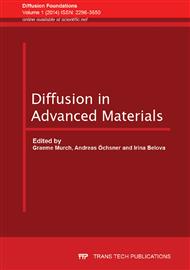[1]
A. Fick, Poggendorffsche Annalen der Physik 94 (1855) 59-86.
Google Scholar
[2]
T. Graham, Philosophical Transactions 151 (1861) 183-224.
Google Scholar
[3]
J. Stefan, Sitzungsbericht der Wiener Akademie 79 II (1879) 161-214.
Google Scholar
[4]
W. Kawalki, Annalen der Physik und Chemie 52 (1894) 166-190.
Google Scholar
[5]
W. Seith, J.G. Laird, Zeitschrift für Metallkunde 24 (1932) 193-196.
Google Scholar
[6]
O. Wiener, Wiedemannsche Annalen 49 (1983) 105-149.
Google Scholar
[7]
L. Boltzmann, Annalen der Physik und Chemie 53 (1894) 959-964.
Google Scholar
[8]
V. Hausmaninger, Sitzungsbericht der Wiener Akademie 86 (1882) 1073-1089.
Google Scholar
[9]
K. Waitz, Annalen der Physik und Chemie, Neue Folge, Band XVII, (1882). 201-236.
Google Scholar
[10]
W. Roberts-Austen, Phil. Trans. R. Soc. Lond 187 (1896a) 383-415.
Google Scholar
[11]
W. Seith, Diffusion in Metallen, Springer, Berlin 1939, pp.55-66.
Google Scholar
[12]
G. Grube, Zeitschrift für Metallkunde 19 (1927) 438-447.
Google Scholar
[13]
G. Grube, W. Fischbein, Zeitschr. f. anorg. u. allg. Chemie 154 (1926) 314-332.
Google Scholar
[14]
G . Grube, A. Jedele, Zeitschrift für Elektrochemie 38 (1932) 799-807.
Google Scholar
[15]
G. Grube, F. Lieberwirth, Zeitschrift für anorganische Chemie 188 (1930) 274-289.
Google Scholar
[16]
G. v. Hevesy, W. Seith, Zeitschrift für Elektrochemie 37 (1931) 528-531.
Google Scholar
[17]
C. Matano, Japanese Journal of Physics 8 (1933) 109-113.
Google Scholar
[18]
J.W. Christian, Theory of Transformations in Metals and Alloys, Pergamon, Oxford, (1965).
Google Scholar
[19]
L.S. Darken, R.W. Gurry, Physical Chemistry of Metals McGraw-Hill, New York (1953).
Google Scholar
[20]
R. W. Cahn, The Coming of Materials Science, Pergamon, Amsterdam, (2001).
Google Scholar
[21]
E.O. Kirkendall, Trans AIME 147 (1942) 104-109.
Google Scholar
[22]
H. Nakajima, JOM 49(6) (1997) 15-19.
Google Scholar
[23]
H.B. Huntington, F. Seitz, Phys. Rev. 61 (1942) 315-325.
Google Scholar
[24]
A.S. Nowick, Ann. Rev. Mater Sci. 26 (1996) 1-19.
Google Scholar
[25]
A. Paul, Met. Mater. Trans A 44 (2013) 5622-5623.
Google Scholar
[26]
H. Mehrer, Mater. Trans JIM 37 (1996) 1259-1280.
Google Scholar
[27]
W. Sprengel, Th.A. Lograsso, H. Nakajima, Phys. Rev. Lett. 77 (1996) 5233-5236.
Google Scholar
[28]
F. Ye, W. Sprengel, R.K. Wunderlich, H. -J. Fecht, H. -E. Schaefer, Proc. Nat. Acad. Sci. 104 (2007) 12962-12965.
DOI: 10.1073/pnas.0705221104
Google Scholar
[29]
M. Koiwa, W. Sprengel: (in Japanese) Materia (Japan Inst. of Metals) 46 (2007) 682-688.
Google Scholar


